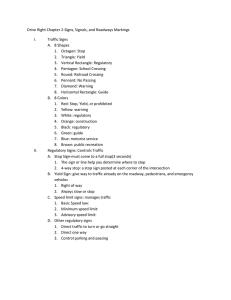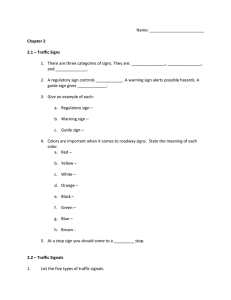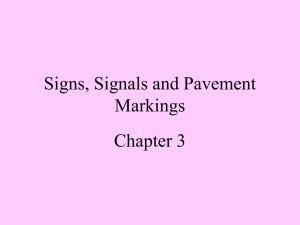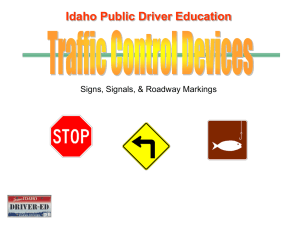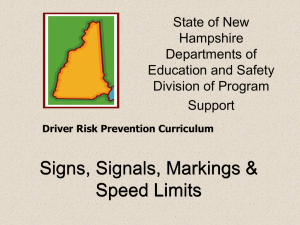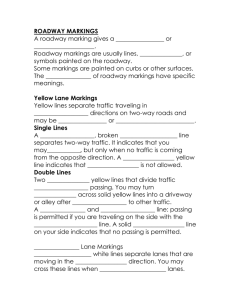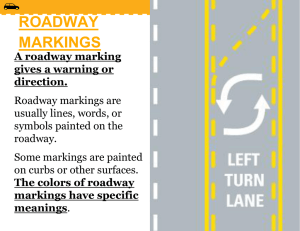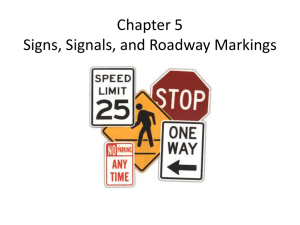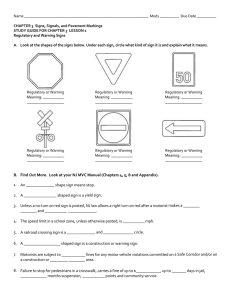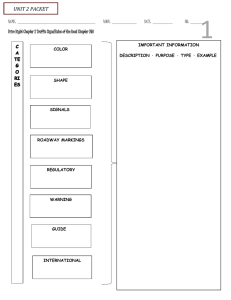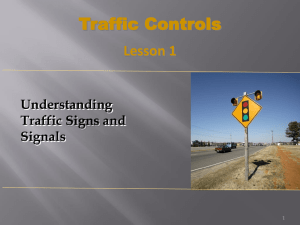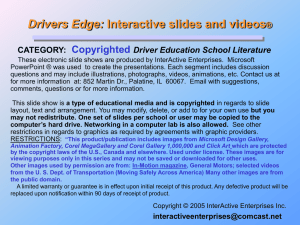Chapter 2 & 4 Drive Right Notes
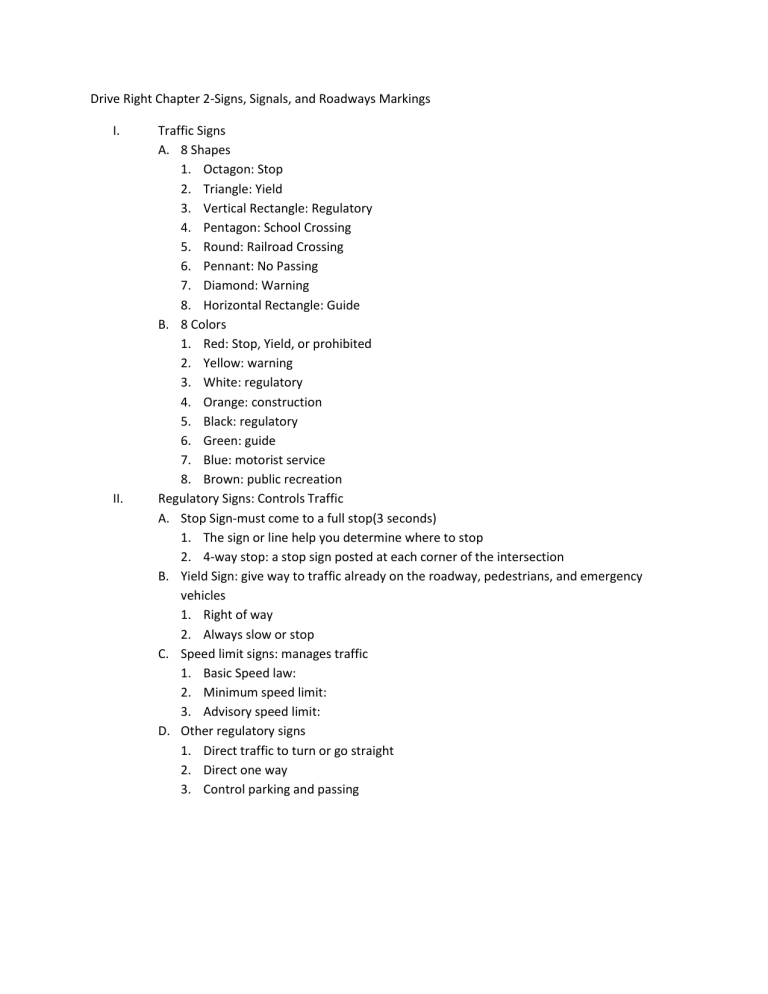
Drive Right Chapter 2-Signs, Signals, and Roadways Markings
I.
II.
Traffic Signs
A.
8 Shapes
1.
Octagon: Stop
2.
Triangle: Yield
3.
Vertical Rectangle: Regulatory
4.
Pentagon: School Crossing
5.
Round: Railroad Crossing
6.
Pennant: No Passing
7.
Diamond: Warning
8.
Horizontal Rectangle: Guide
B.
8 Colors
1.
Red: Stop, Yield, or prohibited
2.
Yellow: warning
3.
White: regulatory
4.
Orange: construction
5.
Black: regulatory
6.
Green: guide
7.
Blue: motorist service
8.
Brown: public recreation
Regulatory Signs: Controls Traffic
A.
Stop Sign-must come to a full stop(3 seconds)
1.
The sign or line help you determine where to stop
2.
4-way stop: a stop sign posted at each corner of the intersection
B.
Yield Sign: give way to traffic already on the roadway, pedestrians, and emergency vehicles
1.
Right of way
2.
Always slow or stop
C.
Speed limit signs: manages traffic
1.
Basic Speed law:
2.
Minimum speed limit:
3.
Advisory speed limit:
D.
Other regulatory signs
1.
Direct traffic to turn or go straight
2.
Direct one way
3.
Control parking and passing
III.
Warning Signs: Help you avoid surprise situations
A.
Yellow Diamond
B.
School Signs
C.
NO-passing
D.
Construction
E.
Railroad signs
IV.
Guide Signs: provide information
A.
Route signs
B.
Other signs:
1.
Green: mileage
2.
Blue: service
3.
Brown: points of interest
C.
International Signs
V.
Traffic Signals
A.
Traffic Lights: Red, Yellow(Amber), Green
1.
Right turn on red law(pg 68 in manual)
B.
Flashing Signals
1.
Red: Full stop
2.
Yellow: Caution
C.
Turning Arrows
VI.
Roadway Markings: Gives you a warning or a direction
A.
Yellow Line Markings
1.
Broken Yellow lines separates two-way traffic and passing is allowed
2.
One Solid and One Broken Yellow line passing is only allowed on the broken side
3.
Two solid Yellow lines divides traffic and no passing is allowed
4.
Shared left-turn lane
B.
White line Markings
1.
Broken white lines separate lanes of traffic in the same direction, changing lanes is allowed.
2.
Solid white lines restrict changing and keep drivers in their lanes
3.
White arrows painted in lanes tells you when and where to turn
4.
Solid white lines are used to mark the edge of the roadway, pedestrian crosswalks and stop lines across an intersection
Chapter 4 IPDE Process
I.
Identify
A.
Zone Control System
1.
6 Zones
2.
Open zones:
3.
Line of sight:
4.
Path of Travel: a.
Target area:
5.
Closed Zone:
B.
3 Searching Ranges
1.
Target Area Range
2.
12-15 Second Range
3.
4-6 Second Range
C.
Orderly Visual Search Pattern:
D.
Field of Vision
1.
Central Vision
2.
Peripheral Vision
3.
Scanning
E.
What to Look For
1.
Open Zones
2.
Other Users a.
Ground Viewing
3.
Roadway Features and conditions
4.
Traffic Controls
II.
Predict
A.
Knowledge, Judgment, and Experience
B.
What to Predict
1.
Actions of others a.
Path b.
Action c.
Space d.
Point of conflict
III.
Decide: upon an action
A.
Change Speed
B.
Change Direction
1.
Space Cushion
C.
To Communicate
1.
Headlights, tail lights, Brake Lights
2.
Turn Signals
3.
Hazards
4.
Horn
5.
Car Position
6.
Eye Contact/ Body language
D.
Minimize a hazard:
E.
Separate Space:
F.
Compromise Space:
IV.
Execute: perform action
A.
Control Speed
B.
Steering
C.
Communicate
D.
Combining Actions
